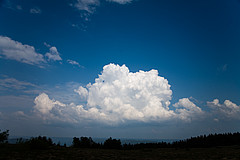Weather and Climate Research:
New Observatory bundles expertise for more precise predictions [06.04.17]
Five research teams at the University of Hohenheim want to improve extreme weather predictions with the new Land-Atmosphere Feedback Observatory (LAFO)
Drought, extreme precipitation, hail storms - precise weather predictions and climate simulation models are still very difficult to make. The new Land-Atmosphere Feedback Observatory (LAFO) at the University of Hohenheim intends to change that. Scientists from five institutes have bundled their expertise and research structures. Together with national and international partners, they are working on enabling more precise advance warnings in the future. The Carl Zeiss Foundation is supporting the project with 800,000 euros over four years.
An area of around 9 square kilometers with agricultural, forest, and urban spaces will set new standards for weather and climate research in the future: On the western side of the University of Hohenheim on the area of the Heidfeldhof, the new Land-Atmosphere Feedback Observatory (LAFO) is being built.
Research at the LAFO will enable a much better understanding and more precise simulation of wind, temperature, and humidity areas in the lower atmospheric layers. For this, the scientists must first analyze evaporation and warming of the atmosphere on the land surface depending on the characteristics of the plants, especially under drought conditions. They will also look into the turbulent transportation of moisture and warmth up to a height of around two kilometers.
“That is a necessary condition for more precise prediction of extreme weather events. Whether clouds are created or not depends largely on how well the model can simulate these complex fields,” emphasizes LAFO director Prof. Dr. Volker Wulfmeyer, climate expert at the University of Hohenheim. “But here the models have serious deficits so that the prediction of clouds and precipitation or droughts is still very difficult. However, it is very important for society and businesses to be able to better predict droughts or heavy precipitation so they can give more precise advance warning.”
These analyses place special demands on sensor systems. In order to achieve this, five research teams from the University of Hohenheim want to work together. In the future, their equipment for climate research will be bundled in the LAFO - along with additional important measurement tools.
Sensors explore atmosphere and land surface
Three components will be elements of the new LAFO:
• Systems for remote sensing:
The so-called LIDAR systems (Light Detection and Ranging) can measure turbulent wind, temperature, and moisture structures in the atmosphere at the same time. They were developed at the University of Hohenheim’s Institute of Physics and Meteorology. “In regard to their precision and three-dimensional sensing characteristics, these systems are absolutely unique in the world,” emphasizes Institute Director Prof. Dr. Wulfmeyer.
• Sensors that measure energy flows on the land surface and the state of the soil and vegetation:
Prof. Dr. Thilo Streck, Institute of Soil Science and Land Evaluation, operates so-called eddy covariance stations. With these measurement stations, he can determine the exchange of energy, water, and trace gases between the land surface and the atmosphere near the soil. In addition, there is a soil moisture measurement network that, among other purposes, serves to investigate the connection between evaporation and soil moisture.
• Devices to characterize vegetation:
A hexacopter at the Institute of Crop Science records the characteristics of plants. The unmanned aerial vehicle from Prof. Dr. Wilhelm Claupein’s team creates spatial sensor data with a high resolution and complements the remote sensors.
A flexible carrier vehicle with intelligent sensor systems collects data on vegetation for the State Plant Breeding Institute at the University of Hohenheim. With the “BreedVision” system, Dr. Tobias Würschum’s team can get information about the appearance of crops. Characteristics such as biomass and the state of the plants, for example, can be determined exactly.
FACE - an abbreviation for “free air carbon dioxide enrichment” is an exposition system for CO2 enrichment outdoors. Prof. Dr. Andreas Fangmeier from the Institute of Landscape and Plant Ecology can use it to create the CO2 concentrations of the future and look into their effects on agricultural ecosystems.
Organizationally, the new LAFO infrastructure at the University of Hohenheim is imbedded in the Hohenheim Research Center for Global Food Security and Ecosystems. “LAFO makes the University of Hohenheim an important location for international research on climate change and on agricultural and nutrition systems,” states Prof. Dr. Wulfmeyer.
Background: Land-Atmosphere Feedback Observatory (LAFO)
Since 1 January 2017, the University of Hohenheim has been establishing the Land-Atmosphere Feedback Observatory (LAFO). The Carl Zeiss Foundation is contributing 800,000 euros in the first four years within its program to strengthen research structures at universities. Homepage: www.lafo.uni-hohenheim.de
Background: Research Center for Global Food Security and Ecosystems (GFE)
Securing global nutrition is one of the University of Hohenheim’s three research concentrations. Due to climate change, the loss of biological diversity, and a disproportionate use of natural resources, it is increasingly threatened. On the one hand, agriculture has to cover the growing demand for food, but it also has to take into consideration that natural resources are scarce. In addition, changes in lifestyles and eating habits are leading to more nutrition problems such as obesity and a lack of micronutrients.
The Hohenheim Research Center for Global Food Security and Ecosystems (GFE) links research topics such as sustainable agricultural production systems, quality and availability of food, access to markets, and the processing, storing, and use of food. A particular focus is thereby placed on development-oriented agricultural research. Homepage: www.gfe.uni-hohenheim.de
Text: Elsner
Contact for press:
Prof. Dr. Volker Wulfmeyer, University of Hohenheim, Institute of Physics and Meteorology, T +49 (0)711 459 22150, E volker.wulfmeyer@uni-hohenheim.de


